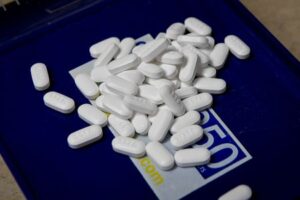By Hyunjoo Jin and Akash Sriram
(Reuters) -Tesla said on Tuesday it would introduce “new models” by early 2025 using its current platforms and production lines as it retreated from more ambitious plans to produce an all-new model that had been expected to cost $25,000.
The talk of new offerings on a faster timeline sent Tesla shares soaring in after-hours trading, a much-needed boost, after months of decline during which Tesla has struggled with fierce competition and falling sales. The gains came despite Tesla releasing first-quarter results that missed Wall Street expectations.
Chief Executive Elon Musk declined to provide details of the new vehicles but said they would include more-affordable models that would start production by early 2025. That’s just before the target Musk previously set for launching the all-new low-cost model widely known as the Model 2.
Reuters exclusively reported on April 5 that Tesla had scrapped plans for the Model 2, which investors had expected to drive Tesla’s growth into a mass-market automaker. Musk initially reacted to that story with a post on his social platform X saying “Reuters is lying,” without pointing out any inaccuracies.
On Tuesday, neither Tesla nor Musk directly addressed the Reuters report.
Instead, they discussed unidentified new models that appeared to be different products, without saying how many, what type or providing their target prices.
The new models would be built on Tesla’s current manufacturing lines and use “aspects” of its current platform and a next-generation platform, Tesla said. It cautioned that this plan may “result in achieving less cost reduction than previously expected,” suggesting that the vehicles may cost consumers more than the Model 2’s anticipated $25,000 price.
The automaker said its plan for new models would let it better control capital expenditures during “uncertain times.”
Tesla engineering chief Lars Moravy said the company would avoid the risk of investing in a “revolutionary” manufacturing process. Musk has said previously the all-new affordable car would be a test bed for manufacturing innovation.
Moravy said Tesla’s work on the next-generation affordable car is “transferable” to the vehicles the automaker now aims to release early next year.
“That engineering work, we’re not trying to just throw it away,” Moravy said. “We’re going to take it and utilize it.”
Musk declined to answer an analyst’s question about whether the new vehicles would be all-new models, or tweaks to existing vehicles.
“I think we’ve said all we will on that front,” Musk said.
One observer took Tesla’s comments on new models as a confirmation that it had halted plans for the Model 2.
“It seems clear that the new vehicle platform has indeed been shelved for now,” said Sam Abuelsamid, an analyst at Guidehouse Insights. “The next gen vehicle was supposed to use fundamentally different production processes from current models. With no desire to spend billions on new production facilities or retool existing factories, it seems like we will see Tesla continue to build the current products.”
Currently, Tesla’s Model 3 and Model Y, with starting prices of around $40,000, are its only volume sellers.
ROBOTAXIS ON THE AIRBNB, UBER MODEL
Tesla also mentioned a “purpose-built robotaxi product” that it planned to build with a “revolutionary” manufacturing process, without offering a timeline for its release. The April 5 Reuters story reported that Tesla planned to continue developing a self-driving robotaxi on the same platform it had been developing for the Model 2.
Musk devoted much of the call with analysts to outlining ambitious visions for diversifying Tesla’s business into artificial intelligence, humanoid robots and operating a fleet of millions of autonomous vehicles – all based on software and hardware products the automaker has not yet fully developed.
Tesla “should be thought of as an AI robotics company,” not a car maker, Musk said.
The statement implies a substantial change in Tesla’s fundamentals. More than 80% of Tesla’s revenue in the first quarter came from selling electric cars.
Musk said Tesla’s self-driving vehicle fleet will be “like a combination of Airbnb and Uber.” Some vehicles will be owned and operated by Tesla, others will be vehicles owned by individuals but rented out on Tesla’s network.
The comments echoed a presentation from Musk in 2019, when he said a “robotaxi network” would be operating by 2020.
The 12.5% rise of Tesla shares in extended trading added about $57 billion to Tesla’s market capitalization, recovering some losses from a plunge of more than 40% so far this year.
‘SHOW-ME STOCK’
Tesla’s plan for more affordable cars pleased investors despite its weak quarterly results after the bell. But some remained skeptical.
“Sounds promising, but Tesla is becoming more of a show-me stock based on how many delays we’ve seen in previous roll outs,” said Jay Woods, chief global strategist at Freedom Capital Markets. “If they can deliver, then this is a great development.”
The more modest strategy could also save Tesla substantial investments in a redesigned car and new production lines to build it. Tesla’s decision to tap the brakes on adding manufacturing capacity mirrors similar decisions at General Motors and Ford Motor in response to slowing growth in EV demand in the United States and intensifying competition from Chinese EV makers in the world’s largest auto market.
“Global EV sales continue to be under pressure as many carmakers prioritize hybrids over EVs,” Tesla warned.
Tesla’s quarterly revenue fell for the first time since 2020, when the COVID-19 pandemic hampered production and deliveries.
The company on Tuesday reported revenue of $21.3 billion for the three months ended March, compared with $23.33 billion a year earlier. Analysts on average had estimated $22.15 billion, according to LSEG data.
Tesla’s average revenue per vehicle delivered in the quarter fell by nearly 5% from a year ago to $44,926 a vehicle, reflecting the impact of repeated price cuts.
Net profit in the first quarter stood at $1.13 billion, compared with $2.51 billion, a year earlier.
Tesla began the second quarter announcing it will lay off more than 10% of its global workforce and slash vehicle prices in major markets such as the United States, China and Europe.
(Reporting by Akash Sriram in Bengaluru and Hyunjoo Jin in San Francisco; Additional reporting by Noel Randewich in Oakland, California, Joe White in Detroit and Abhirup Roy in San Francisco; Editing by Brian Thevenot, Peter Henderson and Christopher Cushing)




